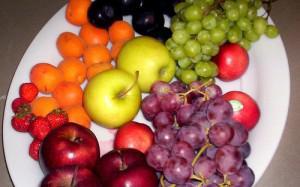 If you are trying to be conscious about your food choices, then there are many options to choose from.
If you are trying to be conscious about your food choices, then there are many options to choose from.
- Do you choose to buy all of your food certified organic? Often these foods are miles from your house, generally produced in California or on the west coast.
- Do you choose to buy all your food within 100 miles, or less, and be a locavore? If you choose this your food will not necessary be organic (unless you live in California where most of our produce comes from).
- Or do you choose to eat foods within season? Only eating asparagus in the spring, apples in the fall and berries in the summer.
But what is the best option? That is a tough choice to make with each option having their pros and cons.
- Organic foods have a lesser impact on the environment in production since they use less or no pesticides. But is that offset when it has to travel at least a thousand miles to the consumer? Also, organic foods are generally more expensive for the consumer to buy over conventional foods.
- The opposite is true for locavores, while you can get organic foods local, sometimes not everything is available organic within 100 miles or less. Unless you live in the Midwest, generally wheat and corn are not grown.
- When eating in season you should be able to find local foods and organic (but not always local) foods, but it means you cannot eat whatever you want when you want.
I feel that in order to be sustainable in our food choices we need to incorporate all of these options in our food buying. When you are able to buy organic or when you can afford it you should buy it since it it is better for environmental sustainability and your health. When foods are available from a local source you should always get it because it generally will be fresher (meaning taste better) and will be better for the environment because of less transportation. I separate locavore and eating in season because some items you can eat in season even if they are not grown in your area, such as berries, pomegranates, asparagus, and citrus fruits.
There also needs to be a change in the way we think and shop as consumers. This means we should not eat a banana a day since they are shipped from Mexico and Central America. Or expecting apples, oranges, grapes and berries in the supermarket every day. It is not sustainable to be producing these foods every season. Most seasonal foods end up coming from Mexico, Central America and South America in the fall and winter months because they are not able to grow in the U.S. at this time but consumers are still demanding these items. The sad thing is we are willing to pay for these items that often are poor in quality. Tomatoes grown in winter months and then refrigerated and shipped thousands of miles are generally tasteless and mealy, so why are we demanding this? The best tomatoes come from your backyard in the summer.
In order to have a sustainable food system we need to change our way of eating and what we are demanding. But it will have to start on an individual level with us changing the system by changing our demands with our food purchases. So the next time you go to the grocery store, consider what you are buying. Is it local? Seasonal? Or organic? Are your choices sustainable? Sadly, this is just one step in making a sustainable food system, but it is the most important step and the hardest to make.
[Image source]

